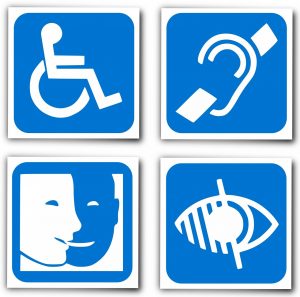 Often I read an article or blog post and suddenly find that I am falling down a rabbit hole. Hours, or even days, later I emerge, having uncovered a wealth of information and resources that have to be edited down in order to present a reasonably digestible overview of a topic for you readers. Such was the case with David Gooblar’s post Now is the Time to Think About Accessibility on his Chronicle Vitae Pedagogy Unbound blog (August 8, 2017). From the links in his article, I went on to discover other great material on accessibility to share—enough good stuff for two posts. This first post will cover thinking about accessibility in your classroom in general; next will be a follow-up post focused on creating an accessible syllabus and other documents for your class.
Often I read an article or blog post and suddenly find that I am falling down a rabbit hole. Hours, or even days, later I emerge, having uncovered a wealth of information and resources that have to be edited down in order to present a reasonably digestible overview of a topic for you readers. Such was the case with David Gooblar’s post Now is the Time to Think About Accessibility on his Chronicle Vitae Pedagogy Unbound blog (August 8, 2017). From the links in his article, I went on to discover other great material on accessibility to share—enough good stuff for two posts. This first post will cover thinking about accessibility in your classroom in general; next will be a follow-up post focused on creating an accessible syllabus and other documents for your class.
Gooblar starts off by noting that for many instructors, accessibility is given a brief mention at the end of the syllabus and then forgotten. Accessibility is seen as “an exception to the norm” and given little thought. He then notes an article by Anne-Marie Womack, assistant director of writing at Tulane University, which takes issue with that way of “conceptualizing accessibility.”
Teaching Is Accommodation: Universally Designing Composition Classrooms and Syllabi (College Composition and Communication, February 2017) by Anne-Marie Womack should be required reading for all higher ed instructors. [Note: if the link does not work, try copying and pasting this URL directly into your browser: http://www.ncte.org/library/NCTEFiles/Resources/Journals/CCC/0683-feb2017/CCCC0683Teaching.pdf.] It is an important document that asks us to rethink disability and academic accommodations. She starts by discussing “contemporary theories of disability to retheorize accommodation as the process of teaching itself.” Womack provides a history of disability law and American institutions of higher education, noting that students today must “pass substantial hurdles to qualify for accommodations” often at the risk of being stigmatized. Faculty, who may receive little institutional support, come to feel that they are the ones burdened by the process. Any resulting pedagogical changes are seen as affecting only the students with disabilities.
Womack argues that resistance to accommodation by university administration and faculty assumes that accommodations are an exception to a rule, to a best practice, or normal way of teaching. Womack states, “Ultimately, though, there is no normal, primary way of learning, only normalized methods made primary through frequent use. Material always changes as it moves from expert to novice. Every act of teaching is an accommodation because it creates certain conditions for students to learn and display learning.” Even though effective student learning means that the material is accessible, instructors have come to feel that “making material accessible to disabled students threatens academic rigor.”
Seen from another vantage point, inclusive teaching means eliminating barriers to learning, not eliminating intellectual challenges. Womack says, “Accommodation is the most basic act and art of teaching. It is not the exception we sometimes make in spite of learning, but rather the adaptations we continually make to promote learning.” She advocates accommodation of disabled students within a universal design framework.
“Universal Design is the design and composition of an environment so that it can be accessed, understood and used to the greatest extent possible by all people regardless of their age, size, ability or disability.” Universal design is good for everyone. In your classroom, Womack suggests, for example, considering guidelines for dyslexic and blind readers, working under the assumption that by creating documents that more students can read, more students will read. She warns, however, that universal design must be used as a process, not to negate the need for accommodations, but to start to negotiate the means to accessibility for all.
In my next post I will look at the second part of Womack’s article, which provides suggestions for creating accessible documents, engaging students by using “cooperative language” and building flexibility into your course to empower students. “If instructors see the syllabus through the lens of disability, then the question becomes not how policies protect a normative standard but how far they extend inclusion.”
Macie Hall, Senior Instructional Designer
Center for Educational Resources
Image Source: Pixabay.com
